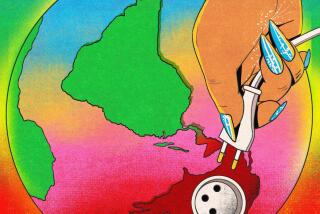Fearing the Worst for Latin American Issues
- Share via
As Latin American stock and bond markets continue to plummet, big-money U.S. investors are torn between a belief that bargains are rampant and a fear that the worst is yet to come.
So far, fear still has the upper hand in that struggle: Many institutional investors are staying on the sidelines.
“It’s just very, very difficult to call a bottom in a situation like this,” said Soraya Betterton, whose San Francisco-based GT Global Latin America stock mutual fund has lost nearly 19% of its value since Jan. 1.
In a sign that yet another selling wave may be imminent, Betterton said individual investors have begun to cash out of her fund, after sitting patiently for weeks as Latin markets slumped.
About $20 million has exited the $400-million GT fund since Monday, Betterton said. If that outflow balloons, she could be forced to liquidate more of her holdings in an already sliding market. “The big fund companies haven’t really seen much in redemptions yet” from Latin funds, Betterton warned. “You can’t really expect a bottom until we have that wave of redemptions.”
Tuesday’s market selloff slashed 6.3% from Mexico’s Bolsa stock index, the equivalent of a 244-point plunge in the Dow Jones industrial average. The main Brazilian and Argentine stock indexes both tumbled nearly 10% on Tuesday..
In the Mexican debt market, yields on short-term bonds have soared far beyond “junk” status. The Mexican government on Tuesday agreed to pay a record 20% interest (annualized) on 28-day dollar-denominated notes, and rates on short-term peso-denominated debt rocketed as high as 56.5%.
For many U.S. investors, this isn’t just another annoying bout of profit-taking in what are always volatile “emerging” markets.
Latin markets also stumbled last spring, victims of fallout from the Federal Reserve Board’s initial interest rate hikes. But in that market plunge, few on Wall Street were questioning the “long-term story” of Latin America’s economic revival.
This time, faith in that fundamental story has been shaken by the severity of Mexico’s financial crisis: a dramatically devalued currency that is groping for a bottom, deepening bank liquidity and loan problems and a growing sense that too much of the Mexican revival story, in particular, was based on flimsy assumptions about that economy’s potential.
Now, the issue is a devastatingly simple one of credit-worthiness. J.P. Morgan Co. economist Marilyn Skiles, speaking in a conference call to investors on Tuesday, conceded that Mexico still is woefully short of dollars to pay off maturing bonds this year, even though First World nations led by the United States have already ponied up $18 billion in credit.
Drained of foreign capital by the run on the peso and by overseas investors’ abrupt decision to yank money from Mexican stocks and bonds as those markets crumbled, Mexico is resorting to outrageously high interest rates to lure some of that foreign cash back.
But those rates in turn are killing local businesses and threatening a vicious downward spiral of a weaker economy, a weaker currency and weaker markets.
The manager of one U.S.-based “hedge” fund, who is accustomed to searching worldwide for investment opportunities and to taking big risks, conceded that some of his peers are raising the question of whether this is Latin America’s 1929--in essence, a crash from which recovery will be difficult and drawn out.
Then again, the history of Latin America--and of emerging markets generally--is one of booms and crashes. Nothing has really changed, some Wall Streeters say, except that a new generation of investors is learning the hard way why they’re called emerging markets.
Tom Robinson, international strategist at Merrill Lynch in New York, warns that just as too many U.S. investors were too caught up in the euphoria over Latin stock markets a year ago, “now you have to guard against becoming too pessimistic” on the future.
“At some point the market is going to conclude that these assets are too low-priced,” Robinson said.
But where is that point? With Mexican issues, “You can argue (rhetorically) that these stocks can go to zero from here,” says David Herro, manager of the Oakmark International fund in Chicago. But as he also notes, zero usually never arrives. “I think we’re at the point where one should definitely start buying,” he said. “The values in the market now are detached from reality. These stocks are priced as if the companies are going to dry up and blow away.”
* CAPITAL FLIGHT
Investors flee Mexico, with shock waves spreading. A1
* TEQUILA EFFECT
Latin markets suffer. D3
(BEGIN TEXT OF INFOBOX / INFOGRAPHIC)
Latin Meltdown
How U.S.-traded shares of key Latin American companies and investment funds have plunged over the past year:
Telmex
1994 high: $76.13
Tuesday: $33.38
Brazil Fund
1994 high: $36.88
Tuesday: $25.67
Empresas ICA
1994 high: $34.50
Tuesday: $9.63
Coca-Cola Femsa
1994 high: $38.38
Tuesday: $20.25
Argentina Fund
1994 high: $19.63
Tuesday: $10.38
Vitro
1994 high: $27.75
Tuesday: $10.75
YPF (Argentina)
1994 high: $29.63
Tuesday: $19.88
Note: All stocks traded on the New York Stock Exchange.
The Losses Deepen
How some mutual funds that focus on “emerging” stock markets fared in 1994 and estimated declines so far this year:
Total return: Fund 1994 1995* Fidelity Latin America -23.2% -20.0% TCW/Dean Witter Latin Am. -23.7 -18.9 GT Global Latin Amer. A -6.6 -18.8 Scudder Latin America -9.4 -17.7 Fidelity Emerg. Mkts -17.9 -10.8 GT Global Emerg. Mkts A -3.8 -9.6 Montgomery Emerg. Mkts -7.7 -8.3 Templeton Devel. Mkts -8.6 -5.5 Invesco Pacific +4.7 -3.3 Merrill Lynch Pacific A +2.9 -3.0
* through Tuesday
Sources: Lipper Analytical Services, Times research
More to Read
Inside the business of entertainment
The Wide Shot brings you news, analysis and insights on everything from streaming wars to production — and what it all means for the future.
You may occasionally receive promotional content from the Los Angeles Times.










